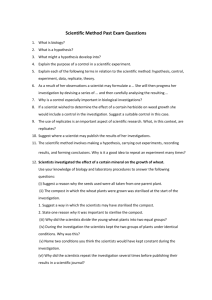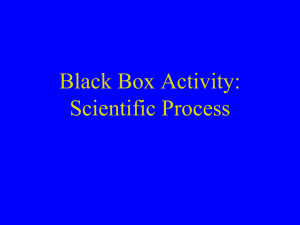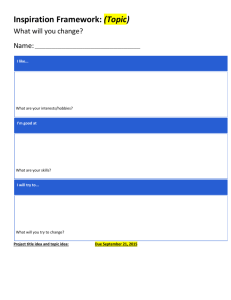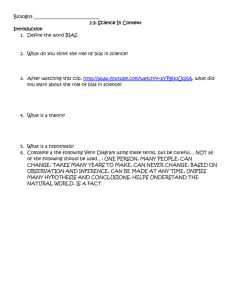Unit 1 Review
advertisement
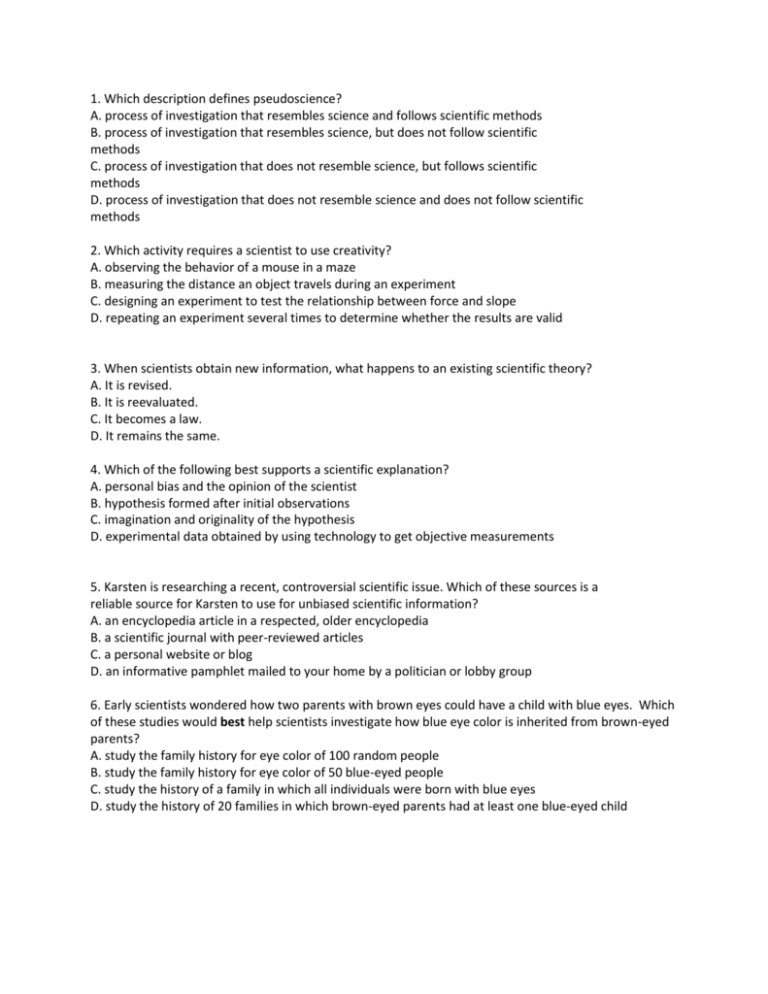
1. Which description defines pseudoscience? A. process of investigation that resembles science and follows scientific methods B. process of investigation that resembles science, but does not follow scientific methods C. process of investigation that does not resemble science, but follows scientific methods D. process of investigation that does not resemble science and does not follow scientific methods 2. Which activity requires a scientist to use creativity? A. observing the behavior of a mouse in a maze B. measuring the distance an object travels during an experiment C. designing an experiment to test the relationship between force and slope D. repeating an experiment several times to determine whether the results are valid 3. When scientists obtain new information, what happens to an existing scientific theory? A. It is revised. B. It is reevaluated. C. It becomes a law. D. It remains the same. 4. Which of the following best supports a scientific explanation? A. personal bias and the opinion of the scientist B. hypothesis formed after initial observations C. imagination and originality of the hypothesis D. experimental data obtained by using technology to get objective measurements 5. Karsten is researching a recent, controversial scientific issue. Which of these sources is a reliable source for Karsten to use for unbiased scientific information? A. an encyclopedia article in a respected, older encyclopedia B. a scientific journal with peer-reviewed articles C. a personal website or blog D. an informative pamphlet mailed to your home by a politician or lobby group 6. Early scientists wondered how two parents with brown eyes could have a child with blue eyes. Which of these studies would best help scientists investigate how blue eye color is inherited from brown-eyed parents? A. study the family history for eye color of 100 random people B. study the family history for eye color of 50 blue-eyed people C. study the history of a family in which all individuals were born with blue eyes D. study the history of 20 families in which brown-eyed parents had at least one blue-eyed child 7. Cosmologists are scientists who study the history of the universe. Some cosmologists theorize that our universe is constantly expanding, or getting larger all the time. Which of these observations is most likely to support this theory? A. galaxies moving farther apart B. galaxies moving closer together C. galaxies not moving away from or toward each other D. galaxies spiraling away and towards each other 8. Which term describes the information that a scientist gathers during an investigation? A. data B. hypothesis C. observation D. variable 9. Juan, a biologist, notices that a particular group of humming birds leaves during the colder winter months and returns during the warmer spring months. Juan hypothesizes that the birds fly south to locations with warmer weather and blooming flowers during the winter months. Which procedure should Juan use to test his hypothesis? A. Survey northern and southern residents about the birds in their areas. B. Observe the direction the birds fly when they depart in the winter. C. Tag the humming birds with transmitters and track their movement. D. Set up observation posts in the south to verify the time of year that birds arrive. 10. Ana is in charge of studying how air quality affects the respiratory health of the citizens in her state. Which testable statement does she investigate? A. The quality of the air varies throughout the state. B. Air quality in her state is worse than it is in other states. C. Air quality has a relationship to respiratory problems. D. Air quality is worsening due to increasing population and industrialization. 11. A microbiologist investigates the outbreak of an unknown illness, which is thought to be caused by a new strain of bacteria. Doctors have determined the bacteria are located in the lungs. Initial work on treating the illness is dependent upon analysis of the bacteria. Which investigational method should the microbiologist use to start the process to analyze the bacteria? A. Review the patients’ medical charts. B. Interview people who have become sick. C. Review the treatment medications and their effectiveness. D. Take samples of the bacteria and grow cultures in a lab setting. 12. Scientists often use visual or mathematical representations to investigate items that are very large, very small, or otherwise difficult to study. What are these visual or mathematical representations called? A. experiments B. hypotheses C. models D. observations 13. Identifying the independent and dependent variables in an experiment will help you better interpret and convey results. What is the difference between the independent and dependent variables in an experiment? A. The independent variable is always a number, and the dependent variable is never a number. B. The independent variable is the title of a data table and the dependent variable is recorded in one of the columns. C. The dependent variable is what the investigator controls, and the independent variable is what happens as a result of this. D. The dependent variable and the independent variable are each recorded in a column of a data table. 14. Which of the following are debates that science is involved in in today’s world? A. global climate change B. same sex marriage C. “going green” D. Evolving the car industry to be less dependent on crude oil E. more than one of the above 15. Which of the following are lab safety rules that MUST be followed when working in a laboratory? A. Work without a teacher present. B. Wear safety goggles and gloves at all times. C. Be sure to chew gum while conducting an experiment. D. Drinking water is okay in the lab, but any other liquid is not okay to drink. 16. What resources are available in case of an emergency when working in the laboratory? A. Eye wash station B. Chemical shower C. Fire extinguisher D. All of the above 17. When dissecting a frog in a laboratory, it is okay to do the following… A. Horse around B. Point your scalpel at your lab partners C. Work quietly and efficiently to complete the dissection in the time provided D. Be extremely noisy and rowdy to annoy Mrs. Carmody 18. Which of the following is not a type of scientific investigation? A. Observation B. Survey C. Controlled experiment D. Model E. All of the above are types of scientific investigations 19. The independent variable is A. The thing in the experiment that the scientist changes. B. The thing in the experiment that changes because of the experiment. C. The thing in the experiment that is kept the same. D. None of the above. 20. A hypothesis is… A. an educated guess B. a prediction based on previously knowledge C. an observation D. a conclusion based on the results of the experiment ANSWER KEY 1. Which description defines pseudoscience? A. process of investigation that resembles science and follows scientific methods B. process of investigation that resembles science, but does not follow scientific methods C. process of investigation that does not resemble science, but follows scientific methods D. process of investigation that does not resemble science and does not follow scientific methods 2. Which activity requires a scientist to use creativity? A. observing the behavior of a mouse in a maze B. measuring the distance an object travels during an experiment C. designing an experiment to test the relationship between force and slope D. repeating an experiment several times to determine whether the results are valid 3. When scientists obtain new information, what happens to an existing scientific theory? A. It is revised. B. It is reevaluated. C. It becomes a law. D. It remains the same. 4. Which of the following best supports a scientific explanation? A. personal bias and the opinion of the scientist B. hypothesis formed after initial observations C. imagination and originality of the hypothesis D. experimental data obtained by using technology to get objective measurements 5. Karsten is researching a recent, controversial scientific issue. Which of these sources is a reliable source for Karsten to use for unbiased scientific information? A. an encyclopedia article in a respected, older encyclopedia B. a scientific journal with peer-reviewed articles C. a personal website or blog D. an informative pamphlet mailed to your home by a politician or lobby group 6. Early scientists wondered how two parents with brown eyes could have a child with blue eyes. Which of these studies would best help scientists investigate how blue eye color is inherited from brown-eyed parents? A. study the family history for eye color of 100 random people B. study the family history for eye color of 50 blue-eyed people C. study the history of a family in which all individuals were born with blue eyes D. study the history of 20 families in which brown-eyed parents had at least one blue-eyed child 7. Cosmologists are scientists who study the history of the universe. Some cosmologists theorize that our universe is constantly expanding, or getting larger all the time. Which of these observations is most likely to support this theory? A. galaxies moving farther apart B. galaxies moving closer together C. galaxies not moving away from or toward each other D. galaxies spiraling away and towards each other 8. Which term describes the information that a scientist gathers during an investigation? A. data B. hypothesis C. observation D. variable 9. Juan, a biologist, notices that a particular group of humming birds leaves during the colder winter months and returns during the warmer spring months. Juan hypothesizes that the birds fly south to locations with warmer weather and blooming flowers during the winter months. Which procedure should Juan use to test his hypothesis? A. Survey northern and southern residents about the birds in their areas. B. Observe the direction the birds fly when they depart in the winter. C. Tag the humming birds with transmitters and track their movement. D. Set up observation posts in the south to verify the time of year that birds arrive. 10. Ana is in charge of studying how air quality affects the respiratory health of the citizens in her state. Which testable statement does she investigate? A. The quality of the air varies throughout the state. B. Air quality in her state is worse than it is in other states. C. Air quality has a relationship to respiratory problems. D. Air quality is worsening due to increasing population and industrialization. 11. A microbiologist investigates the outbreak of an unknown illness, which is thought to be caused by a new strain of bacteria. Doctors have determined the bacteria are located in the lungs. Initial work on treating the illness is dependent upon analysis of the bacteria. Which investigational method should the microbiologist use to start the process to analyze the bacteria? A. Review the patients’ medical charts. B. Interview people who have become sick. C. Review the treatment medications and their effectiveness. D. Take samples of the bacteria and grow cultures in a lab setting. 12. Scientists often use visual or mathematical representations to investigate items that are very large, very small, or otherwise difficult to study. What are these visual or mathematical representations called? A. experiments B. hypotheses C. models D. observations 13. Identifying the independent and dependent variables in an experiment will help you better interpret and convey results. What is the difference between the independent and dependent variables in an experiment? A. The independent variable is always a number, and the dependent variable is never a number. B. The independent variable is the title of a data table and the dependent variable is recorded in one of the columns. C. The dependent variable is what the investigator controls, and the independent variable is what happens as a result of this. D. The dependent variable and the independent variable are each recorded in a column of a data table. 14. Which of the following are debates that science is involved in in today’s world? A. global climate change B. same sex marriage C. “going green” D. Evolving the car industry to be less dependent on crude oil E. more than one of the above 15. Which of the following are lab safety rules that MUST be followed when working in a laboratory? A. Work without a teacher present. B. Wear safety goggles and gloves at all times. C. Be sure to chew gum while conducting an experiment. D. Drinking water is okay in the lab, but any other liquid is not okay to drink. 16. What resources are available in case of an emergency when working in the laboratory? A. Eye wash station B. Chemical shower C. Fire extinguisher D. All of the above 17. When dissecting a frog in a laboratory, it is okay to do the following… A. Horse around B. Point your scalpel at your lab partners C. Work quietly and efficiently to complete the dissection in the time provided D. Be extremely noisy and rowdy to annoy Mrs. Carmody 18. Which of the following is not a type of scientific investigation? A. Observation B. Survey C. Controlled experiment D. Model E. All of the above are types of scientific investigations 19. The independent variable is A. The thing in the experiment that the scientist changes. B. The thing in the experiment that changes because of the experiment. C. The thing in the experiment that is kept the same. D. None of the above. 20. A hypothesis is… A. an educated guess B. a prediction based on previously knowledge C. an observation D. a conclusion based on the results of the experiment

